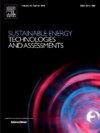双碳目标下中国煤炭产业链协调发展及供应链弹性评价与产业效率
IF 7.1
2区 工程技术
Q1 ENERGY & FUELS
Sustainable Energy Technologies and Assessments
Pub Date : 2025-07-14
DOI:10.1016/j.seta.2025.104434
引用次数: 0
摘要
在煤炭行业,仅仅关注弹性或效率是不够的。它们的协调发展对实现“双碳”目标、保障能源安全至关重要。本研究结合弹性与协同理论,利用2000 - 2023年的统计数据,构建了中国煤炭产业链与供应链弹性(RCICSC)与煤炭工业效率(CIE)的评价体系。采用熵- topsis模型和超效率SBM模型分别度量RCICSC和CIE,采用改进的耦合协调度(MCCD)模型和障碍度模型分析协调发展水平和障碍因素。研究结果表明:(1)受政策干预和外部冲击的影响,2012年农村生产总值呈波动上升趋势,超过平均水平。(2) CIE持续保持高水平,反映出可持续性增强。(3) RCICSC与CIE的协调水平有所提高,由中度不平衡向中度协调过渡。(4)煤炭国内供给潜力、固定资产投资、煤炭产业总产值和利润是制约煤炭产业发展的主要障碍。在此基础上,本文提出了有针对性的政策建议,以促进区域能源安全与环境保护的协调发展,促进能源安全与环境保护的互利互动。本文章由计算机程序翻译,如有差异,请以英文原文为准。

Coordinated development of China’s coal industrial chain and supply chain resilience evaluation and industrial efficiency under the dual carbon goals
In the coal industry, a sole focus on either resilience or efficiency proves inadequate. Their coordinated development is critical to achieving the Dual Carbon goals and ensuring energy security. This study integrates resilience and synergy theory to construct the evaluation system for the resilience of China’s coal industrial chain and supply chain (RCICSC) and coal industrial efficiency (CIE) using statistical data from 2000 to 2023. The entropy-TOPSIS and super-efficiency SBM models are employed to measure RCICSC and CIE, respectively, while a modified coupling coordination degree (MCCD) model and obstacle degree model analyze the level of coordinated development and the obstacle factors. The results indicate: (1) Influenced by policy interventions and external shocks, the RCICSC exhibited a fluctuating upward trend, exceeding the average level in 2012. (2) CIE remains consistently high, reflecting enhanced sustainability. (3) The level of coordination between RCICSC and CIE improved, transitioning from moderate imbalance to moderate coordination. (4) Key obstacles include the domestic supply potential of coal, investment in fixed assets, total output value and profit of the coal industry. Based on this study’s findings, this paper proposes targeted policy implications to enhance the coordinated development of RCICSC and CIE, fostering a mutually beneficial interplay between energy security and environmental protection.
求助全文
通过发布文献求助,成功后即可免费获取论文全文。
去求助
来源期刊

Sustainable Energy Technologies and Assessments
Energy-Renewable Energy, Sustainability and the Environment
CiteScore
12.70
自引率
12.50%
发文量
1091
期刊介绍:
Encouraging a transition to a sustainable energy future is imperative for our world. Technologies that enable this shift in various sectors like transportation, heating, and power systems are of utmost importance. Sustainable Energy Technologies and Assessments welcomes papers focusing on a range of aspects and levels of technological advancements in energy generation and utilization. The aim is to reduce the negative environmental impact associated with energy production and consumption, spanning from laboratory experiments to real-world applications in the commercial sector.
 求助内容:
求助内容: 应助结果提醒方式:
应助结果提醒方式:


